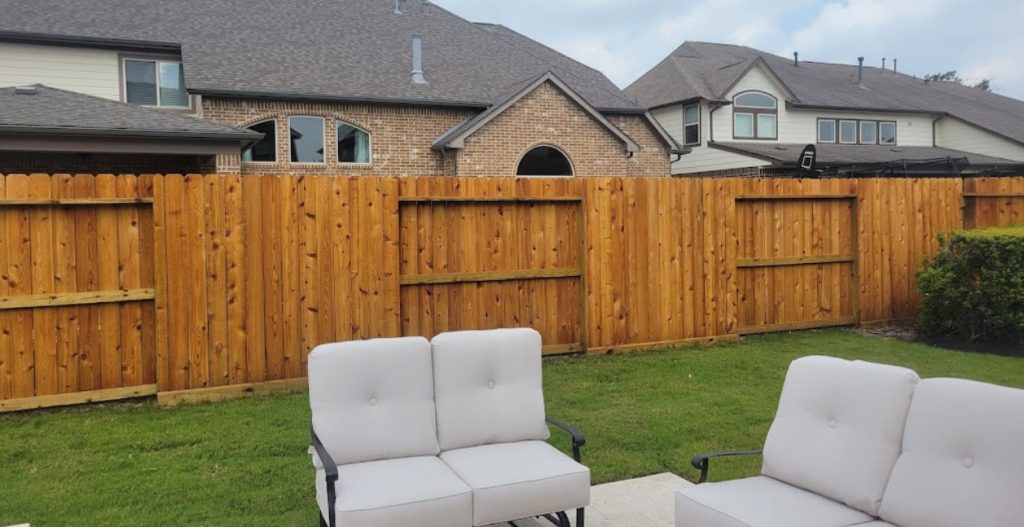How to Install Good Neighbor Fences for Privacy
If you’re yearning for peace and privacy without sacrificing your view and relationship with your neighbors, then a Good Neighbor Fence might top your wishlist right now! In this post, we will guide you step-by-step through the process of installing these ingenious structures. With an array of design ideas and material choices that ensure longevity and aesthetic appeal, neighbor-friendly fences can be personalized to suit your property while enhancing your privacy. So let’s get into it; unlock the secrets of creating harmony between seclusion and friendliness with a good neighbor fence. Dive in to learn more!
A Good Neighbor Fence is a style of fence that is designed to look visually appealing from both sides. It involves placing boards alternatively on each side of the fence, providing a uniform look and maintaining privacy for both neighbors. This means that both neighbors can enjoy the benefits of the fence without it looking unsightly on one side. If you’re looking for a fence option that balances privacy and aesthetic appeal, a Good Neighbor Fence may be right for you.

Benefits of Good Neighbor Fences
When considering installing a fence, one option that stands out is the good neighbor fence. This type of fencing offers several benefits that make it a popular choice among homeowners.
Firstly, good neighbor fences promote harmony and positive relationships with your neighbors. These fences are designed to have an identical appearance on both sides, ensuring that neither neighbor feels like they have received the ‘less attractive’ side of the fence. By maintaining a consistent and aesthetically pleasing look, good neighbor fences can prevent any potential disputes or conflicts between neighbors.
Imagine this scenario: You and your next-door neighbor decide to install a fence for privacy and security purposes. With a traditional fence design, one side would have the rails facing outward, while the other side would show only vertical posts. This could lead to disagreements about aesthetics and who should be responsible for maintaining the more visually appealing side of the fence. However, with a good neighbor fence, both sides are similar in appearance, eliminating any potential conflicts and fostering a harmonious relationship.
Aside from promoting neighborly relations, good neighbor fences also offer enhanced security and privacy. The solid construction of these fences helps create a barrier that prevents unwanted intrusions into your property. Furthermore, the height of the fence can be customized to suit your specific needs, further enhancing privacy by blocking the view from outside eyes.
Enhancing Privacy
Privacy is often a significant concern for homeowners seeking peace and tranquility within their own outdoor spaces. Good neighbor fences play an essential role in creating a private sanctuary by blocking unwanted views and distractions from neighboring properties or public areas.
With their solid construction and lack of gaps or openings, good neighbor fences provide an excellent visual barrier. They obstruct prying eyes, ensuring that your backyard remains your personal haven where you can relax, entertain, and enjoy quality time with friends and family without feeling exposed.
Think of a good neighbor fence as your shield against the outside world, ensuring you have the privacy and solitude to truly unwind and make the most of your outdoor living space.
Moreover, good neighbor fences have built-in features that aid in maintaining a sense of privacy. For example, you can add lattice or trellis panels to the top of the fence to increase its height while still allowing natural light to filter through. This additional height not only boosts privacy but also helps reduce noise pollution from adjacent areas.
Let’s say you live in a bustling urban neighborhood with homes in close proximity to each other. By installing a good neighbor fence and incorporating lattice panels at the top, you create a barrier that not only shields your yard from prying eyes but also adds an element of beauty by supporting climbing plants like ivy or bougainvillea. This combination provides both privacy and a visually appealing addition to your outdoor space.
As we’ve seen, good neighbor fences bring a multitude of benefits, including promoting harmony with neighbors and enhancing privacy.
Ensuring Safety
When it comes to installing good neighbor fences for privacy, ensuring safety is of utmost importance. Before undertaking any fencing project, it is crucial to familiarize yourself with local building codes and regulations. These guidelines exist to maintain the safety and structural integrity of the fence.
First and foremost, before digging any holes for the fence posts, it is essential to call your local utility companies to mark the location of underground utilities. This will help prevent accidental damage and ensure that you can safely install your fence without causing disruptions or hazards.
Additionally, consider the surrounding environment when planning your fence installation. If your property is located in a region prone to high winds or severe weather events, it is vital to select fencing materials and designs that can withstand these conditions. This may include opting for sturdy materials like iron, aluminum, or Simtek, which are known for their durability.
Another aspect to consider is the visibility of your fence from the street or from neighboring properties. Ensuring that your fence does not obstruct sightlines for drivers or create potential blind spots is essential for maintaining safety in your neighborhood.
Lastly, if your fence includes gates or access points, it is crucial to invest in reliable hardware and locking mechanisms. This will help enhance security and prevent unauthorized entry onto your property.
By prioritizing safety during the installation process, you can ensure that your privacy fence not only serves its intended purpose but also provides a secure environment for you and your neighbors.
Fence Design Ideas for Privacy
When it comes to designing a good neighbor fence that offers optimal privacy, there are various options to consider. Here are some design ideas to inspire you:
- Vertical Board Fences: These fences feature tightly spaced vertical boards without gaps, providing excellent privacy while adding a sleek and modern aesthetic appeal. They can be constructed using wood, vinyl, or composite materials based on personal preference and maintenance requirements.
- Shadowbox Fences: This style of fence consists of alternating panels that overlap, creating an attractive pattern on both sides. Shadowbox fences offer privacy while still allowing some airflow and natural light to pass through, making them a popular choice for many homeowners.
- Privacy Screens or Panels: Installing standalone privacy screens or panels can be an effective way to add privacy to existing fences or areas in your yard. These screens come in various materials such as wood, metal, or bamboo and can be customized to match your desired level of privacy and aesthetic.
- Lattice Fences: Lattice fences combine privacy with an open and decorative design. They feature crisscrossed strips of wood or vinyl, creating small diamond-shaped openings. Lattice fences are versatile and can be integrated into different fence styles, providing both privacy and visual appeal.
- Living Fences: For a more natural and eco-friendly option, consider planting hedges, tall shrubs, or climbing vines along the perimeter of your property. These living fences not only offer privacy but also enhance landscaping aesthetics and provide environmental benefits.
Remember to consider factors such as maintenance requirements, neighborhood regulations, and the architectural style of your home when selecting the design that suits your needs best.
For instance, if you live in a suburban neighborhood with strict HOA guidelines, you may need to choose a fence design that aligns with their specific requirements to ensure you maintain compliance while prioritizing privacy.
Ideal Fence Heights
When it comes to installing a good neighbor fence for privacy, choosing the right fence height is crucial. The ideal height will depend on several factors such as the purpose of the fence, local regulations, and the level of privacy you desire. Let’s explore some common fence height options and what they offer.
For most residential properties, a standard fence height of around 6 feet is often sufficient to provide a good balance between privacy and aesthetics. This height ensures that your backyard remains secluded while not completely blocking out natural light or making your property appear unwelcoming.
However, there may be instances where you require additional privacy due to unique circumstances, such as living in close proximity to neighboring houses, or if you have concerns about noise or security. In such cases, you might consider taller fence heights ranging from 8 to 10 feet. These taller fences can help create a secluded oasis within your own property.
Here’s a table outlining different fence heights and their purposes:
| Fence Height | Purpose |
| 4-5 feet | Marking property boundaries or enhancing curb appeal |
| 6-7 feet | Balancing privacy with aesthetics for most residential properties |
| 8-10 feet | Providing maximum privacy and addressing specific concerns |
Once you’ve considered the ideal fence height based on your needs, it’s also worth exploring how you can enhance privacy using green walls.
Incorporating Green Walls
Green walls, also known as living walls or vertical gardens, are an excellent way to add a touch of nature while increasing privacy in your outdoor space. By incorporating plants into your fence design, you can create a beautiful and ecologically friendly barrier that not only offers visual screening but also reduces noise pollution and improves air quality.
One popular approach is to incorporate climbing vines on trellises or mesh panels attached to your fence. Plants such as jasmine, ivy, or climbing roses can quickly cover the fence and create a lush green wall that adds charm and privacy to your outdoor area. These climbing plants also attract beneficial insects and birds, contributing to a thriving ecosystem.
Another option is to install freestanding vertical gardens adjacent to your fence. These self-contained structures consist of various plant species arranged in vertical stacks or pockets. They can be easily customized to suit your aesthetic preferences and provide an additional layer of privacy while adding a touch of natural beauty to your space.
Some may argue that incorporating green walls requires additional maintenance and might affect the longevity of the fence. While it’s true that tending to plants may require some effort, many people find gardening to be an enjoyable hobby. Additionally, regular maintenance can help ensure healthy and vibrant plant growth without compromising the integrity of the fence.
Whether you choose climbing vines or freestanding vertical gardens, incorporating green walls into your good neighbor fence design can transform your outdoor space into a private sanctuary teeming with life and natural beauty.
Steps to Install a Good Neighbor Fence
Installing a good neighbor fence not only provides privacy but also promotes harmony with your neighbors. Follow these steps to ensure a successful installation process:
- Consult with your neighbors: Before starting any fence project, it’s essential to talk to your neighbors about your plans. Discuss the design, height, and materials you intend to use. This open line of communication can prevent potential conflicts and ensure that everyone is on board.
- Check local regulations: Research and understand the local zoning rules and homeowner association guidelines in your area. These regulations may dictate the maximum allowable fence height, setback requirements, and material restrictions. Compliance with these regulations is crucial to avoid legal issues in the future.
- Determine property boundaries: Establishing accurate property lines is essential to avoid encroaching on your neighbor’s land or having them encroach on yours. Hiring a professional surveyor can help identify the exact boundaries, which is particularly useful if disputes arise.
- Select the right materials: Choose fence materials that are durable, aesthetically pleasing, and suitable for privacy purposes. Popular options include wood, vinyl, brick, or composite materials like Simtek. Consider factors such as maintenance requirements, budget constraints, and compatibility with the architectural style of your home.
- Prepare the site: Clear any obstructions or debris from the designated fence area. Ensure proper drainage and remove any vegetation that could interfere with the installation process.
- Mark post locations: Use stakes and string to mark where each fence post will be placed along the property line. Make sure they are evenly spaced and follow any recommended spacing guidelines based on the type of material you’re using.
- Dig post holes: Dig holes deep enough to accommodate at least one-third of the total length of each post, ensuring stability and durability over time. The hole diameter should be two to three times wider than the width of the fence post.
- Set the posts: Place the posts in the holes, ensuring they are level and straight. Fill each hole with concrete or gravel and allow it to set according to the manufacturer’s instructions.
- Install the fence panels: Attach the fence panels to the posts using appropriate fasteners based on your chosen material. Ensure they are aligned properly and securely attached to maintain privacy and structural integrity.
- Add finishing touches: Once the main structure is complete, add any desired finishing touches such as decorative caps, trim pieces, or paint/stain to enhance the overall appearance of the fence.
Remember, proper installation is essential for both aesthetic appeal and longevity of your good neighbor fence. If you’re unsure about any steps, consulting a professional fence contractor can provide valuable expertise and ensure a successful installation.
Fence Material Choices for Privacy
When it comes to choosing materials for your good neighbor fence, various options offer both privacy and visual appeal. Consider these popular choices:
- Wood: Wood fences are classic and versatile, offering a natural aesthetic that complements many architectural styles. Cedar and redwood are popular choices due to their natural resistance to decay and insects. Opting for tall boards with no gaps between them ensures maximum privacy.
- Vinyl: Vinyl fences are low-maintenance and can replicate the look of wood without the need for staining or painting. They are durable, resistant to rotting and fading, making them an excellent choice for long-term privacy.
- Simtek: Simtek fences mimic the appearance of stone or brick but at a lower cost and with easier installation. These polyethylene fences can withstand harsh weather conditions, provide sound insulation, and offer exceptional privacy due to their solid construction.
- Brick or Stone: Brick or stone walls provide ultimate privacy while offering a rustic or sophisticated look, depending on your preference. They require professional installation, but the durability and longevity they offer make them a worthwhile investment.
- Metal: Metal fences, such as aluminum or wrought iron, can also provide privacy when combined with materials like wood or composite panels. These fences often feature decorative elements that add a touch of elegance to your good neighbor fence.
Ultimately, the choice of fence material depends on factors such as budget, desired maintenance level, and aesthetic preferences. Take time to explore different options and consider their long-term benefits before deciding.
Maintenance Tips for Your Neighbor Fence
Maintaining your neighbor fence is essential to ensure its longevity, aesthetic appeal, and privacy, as well as fostering good relationships with your neighbors. By implementing regular maintenance practices, you can prevent issues such as deterioration, rotting, or unsightly appearance. Here are some valuable tips to help you keep your neighbor fence in excellent condition:
- Regular Inspection: Start by inspecting your fence regularly to identify any signs of damage or wear. Look for loose boards, sagging panels, or rusted hardware. Addressing these issues promptly will minimize further damage and save you from costly repairs.
- Clean the Fence: Regular cleaning helps prevent dirt, grime, and mold buildup that can weaken the structure over time. Depending on the material of your fence—whether it’s wood, vinyl, or metal—use appropriate cleaning methods and solutions. Scrubbing with a mild detergent and water solution or using a pressure washer (with caution) can often do the trick.
Pro Tip: For wooden fences, be cautious when using a pressure washer as excessive force may damage the wood fibers.
- Repair Damages: If during your inspection you notice any damaged boards, loose nails or screws, or broken sections of the fence, repair them promptly. Replace any deteriorated wood panels or corroded hardware to maintain the structural integrity of the fence.
- Stain or Paint: Applying a protective stain or coat of paint serves multiple purposes: it enhances the appearance of your fence while providing an extra layer of protection against weathering and insect infestation. Follow the manufacturer’s instructions for proper application techniques and recommended products suitable for your specific fence material.
- Trim Vegetation: Overgrown vegetation near the fence can lead to moisture retention and potential damage. Regularly trim back bushes, vines, or tree branches that come into contact with the fence to prevent rotting and reduce the risk of pests accessing your property.
- Protect Against Moisture: Moisture is a common enemy for fences, especially wooden ones. Ensure proper drainage around the fence by keeping soil and debris away from its base. Consider using gravel or installing a trench to divert rainwater away from the fence. Applying a waterproof sealant to wood fences can provide additional protection.
- Winter Preparations: Before winter arrives, take some preventive measures to protect your good neighbor fence from extreme temperatures and moisture buildup. Clear any leaves, debris, or snow accumulation that may put undue stress on the fence structure. Additionally, applying a protective coating or sealant before winter can help shield the wood from harsh weather conditions.
- Regular Maintenance Schedule: Finally, establish a regular maintenance schedule for your good neighbor fence. Set reminders for inspections, cleaning sessions, and necessary repairs. Consistent upkeep will minimize potential problems and extend the lifespan of your fence.
With these maintenance tips in mind, you can preserve the privacy and beauty of your good neighbor fence while ensuring its durability for years to come. Remember, a well-maintained fence not only benefits you but also enhances the overall appearance of your neighborhood.








